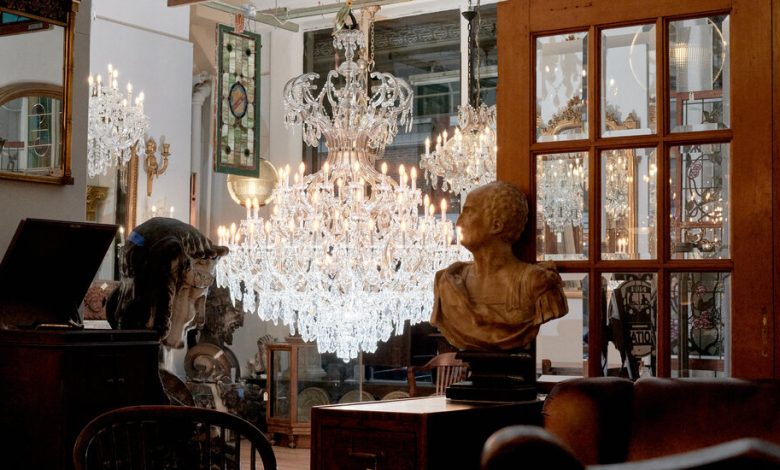Where You Can Still Glimpse the Glory of a Vanished Grand Hotel

An absence rises from the Manhattan pavement, a Seventh Avenue nothingness soaring 22 stories into the Midtown sky. There is vacancy now where the Hotel Pennsylvania once stood.
Its Ionic columns and limestone facade, its guest rooms and conference rooms and dining rooms — gone. Its whistling doormen and bustling bellboys, weekend vacationers and afternoon adulterers, its peddlers and show dogs and tipsy conventioneers, all moving in rhythm to some faint Big Band beat — history.
Demolition crews carried away the last of the century-old hotel in late summer, leaving a void across from Pennsylvania Station that reflects either progress or shortsightedness. Its planned replacement will be a supertall office tower for a city in no need of more office space.
But if you know where to look — say, in a certain Hell’s Kitchen shop window — you might see a dazzling hint of what once filled that absence.
The Hotel Pennsylvania opened in 1919 as the world’s largest hotel, with 2,000 guest rooms and a town of shops and amenities within its brown-brick walls. Radio broadcasts of swinging Big Band music performed at the hotel proved a stroke of marketing genius, with even the hotel’s telephone number made famous by the bandleader Glenn Miller’s 1940 hit song “Pennsylvania 6-5000.”
But changes in travel and entertainment habits over the years forced the hotel to rent out space, and occasional reports of drugs, prostitution and bedbugs — the three banes of the hospitality trade — did little to broaden its appeal. Still, the hotel maintained its sentimental pull as the place where your parents honeymooned; where you spent your first night in the big city; where you rendezvoused with friends.
When a real estate concern, Vornado Realty Trust, became the sole owner in the late 1990s, one didn’t have to be a Hilton to divine that, despite its good bones and rich history, the Hotel Pennsylvania was doomed. Nostalgia rarely pays out.
Vornado closed the hotel during the Covid-19 pandemic in 2020, and then announced the next year that it would be demolishing the building for an office tower only slightly shorter than an unamused neighbor, the Empire State Building.
In late 2021, the hotel’s owners contracted with a company called International Content Liquidations to sell off a century’s worth of stuff. Frank Long, the president of the liquidation firm, recalled the owners’ two central desires: “They wanted as much money as they could get and they wanted the building emptied.”
Long and his team moved into the otherwise empty hotel — he had a suite on the 16th floor — and managed to unload about 90 percent of the items in 45 days: the bed sets, the furnishings, the kitchen equipment, the works. Sold as was, with buyers responsible for removal.
“Then we turned it over to the general contractor, who brought in the demolition,” Long recalled.
The 22-story hotel became 20 stories, then 15, then 12, shrinking almost unnoticed in the heart of Gotham. Then 10 stories, then five — then, in September, gone. On a recent night, the only movement at the site came from two rats hustling like commuters late for the 11:49 to Babylon.
Vornado has announced plans for a 56-story office tower that, according to a company brochure, offers “a quality experience rooted in authentic New York.” The building, it continued, would provide “a workplace experience that is within the essence of N.Y.C. to help draw employees back to office.”
There is more than enough time to decode this language, since tight lending practices and other market realities have forced Vornado to postpone its ambitious plans. For now, the company is exploring ways to generate income from the site through “fashion shows or other temporary uses,” a company official recently said.
Although the Hotel Pennsylvania no longer looms over Seventh Avenue, it lives on: in the furnishings now adorning various hotels; in the collection of a Long Island man named Steven Lepore, who secured a staircase railing in the final days of demolition; in the Glenn Miller song, as well as in the telephone number itself — though a recording tells callers, simply, “We are permanently closed.”
And it lives on in an antique store on West 52nd Street called Olde Good Things, about a mile north of the hotel’s absence. There, in the front window, glistens a massive Maria Theresa-style chandelier that once shimmered in the hotel’s ballroom, its many crystals winking at you in the refracted light.




